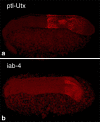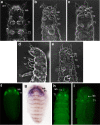Analysis of the Tribolium homeotic complex: insights into mechanisms constraining insect Hox clusters
- PMID: 18392875
- PMCID: PMC2292473
- DOI: 10.1007/s00427-008-0213-4
Analysis of the Tribolium homeotic complex: insights into mechanisms constraining insect Hox clusters
Abstract
The remarkable conservation of Hox clusters is an accepted but little understood principle of biology. Some organizational constraints have been identified for vertebrate Hox clusters, but most of these are thought to be recent innovations that may not apply to other organisms. Ironically, many model organisms have disrupted Hox clusters and may not be well-suited for studies of structural constraints. In contrast, the red flour beetle, Tribolium castaneum, which has a long history in Hox gene research, is thought to have a more ancestral-type Hox cluster organization. Here, we demonstrate that the Tribolium homeotic complex (HOMC) is indeed intact, with the individual Hox genes in the expected colinear arrangement and transcribed from the same strand. There is no evidence that the cluster has been invaded by non-Hox protein-coding genes, although expressed sequence tag and genome tiling data suggest that noncoding transcripts are prevalent. Finally, our analysis of several mutations affecting the Tribolium HOMC suggests that intermingling of enhancer elements with neighboring transcription units may constrain the structure of at least one region of the Tribolium cluster. This work lays a foundation for future studies of the Tribolium HOMC that may provide insights into the reasons for Hox cluster conservation.
Figures





References
-
- {'text': '', 'ref_index': 1, 'ids': [{'type': 'PMC', 'value': 'PMC1203021', 'is_inner': False, 'url': 'https://pmc.ncbi.nlm.nih.gov/articles/PMC1203021/'}, {'type': 'PubMed', 'value': '3098627', 'is_inner': True, 'url': 'https://pubmed.ncbi.nlm.nih.gov/3098627/'}]}
- Abbott MK, Kaufman TC (1986) The relationship between the functional complexity and the molecular organization of the Antennapedia locus of Drosophila melanogaster. Genetics 114:919–942 - PMC - PubMed
-
- {'text': '', 'ref_index': 1, 'ids': [{'type': 'DOI', 'value': '10.1016/j.gde.2003.10.009', 'is_inner': False, 'url': 'https://doi.org/10.1016/j.gde.2003.10.009'}, {'type': 'PubMed', 'value': '14638320', 'is_inner': True, 'url': 'https://pubmed.ncbi.nlm.nih.gov/14638320/'}]}
- Aboobaker A, Blaxter M (2003) Hox gene evolution in nematodes: novelty conserved. Curr Opin Genet Dev 13:593–598 - PubMed
-
- {'text': '', 'ref_index': 1, 'ids': [{'type': 'DOI', 'value': '10.1073/pnas.222671299', 'is_inner': False, 'url': 'https://doi.org/10.1073/pnas.222671299'}, {'type': 'PMC', 'value': 'PMC139232', 'is_inner': False, 'url': 'https://pmc.ncbi.nlm.nih.gov/articles/PMC139232/'}, {'type': 'PubMed', 'value': '12481037', 'is_inner': True, 'url': 'https://pubmed.ncbi.nlm.nih.gov/12481037/'}]}
- Bae E, Calhoun VC, Levine M, Lewis EB, Drewell RA (2002) Characterization of the intergenic RNA profile at abdominal-A and Abdominal-B in the Drosophila bithorax complex. Proc Natl Acad Sci U S A 99:16847–16852 - PMC - PubMed
-
- {'text': '', 'ref_index': 1, 'ids': [{'type': 'DOI', 'value': '10.1038/327247a0', 'is_inner': False, 'url': 'https://doi.org/10.1038/327247a0'}]}
- Beeman RW (1987) A homoeotic gene cluster in the red flour beetle. Nature 327:247–249
-
- {'text': '', 'ref_index': 1, 'ids': [{'type': 'DOI', 'value': '10.1046/j.1365-2583.1997.00159.x', 'is_inner': False, 'url': 'https://doi.org/10.1046/j.1365-2583.1997.00159.x'}, {'type': 'PubMed', 'value': '9013259', 'is_inner': True, 'url': 'https://pubmed.ncbi.nlm.nih.gov/9013259/'}]}
- Beeman RW, Stauth DM (1997) Rapid cloning of insect transposon insertion junctions using ‘universal’ PCR. Insect Mol Biol 6:83–88 - PubMed
Publication types
MeSH terms
Substances
Grants and funding
LinkOut - more resources
Full Text Sources

